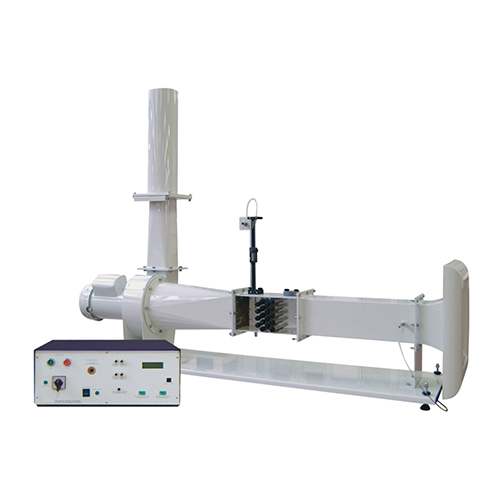TQ TE93 CROSS FLOW HEAT EXCHANGER Vocational Training Equipment Heat Transfer Training Equipment
CROSS FLOW HEAT EXCHANGER
For comprehensive studies into the principles and performance of heat exchangers. The equipment allows students to quickly assess heat transfer rates by forced convection. They monitor the rate of cooling of a body of known thermal capacity in an air flow.
The apparatus is bench mounting. It is a horizontal wind tunnel with a contraction cone, a working section, a diffuser, a constant speed fan, and an exhaust with silencer. A variable slide valve controls the air flow. The working section includes a series of rods arranged in a matrix and at right-angles to the direction of air flow. To do experiments, students can remove any one of these rods and replace it with a cylindrical copper element. The copper element is of known thermal capacity and includes a built-in thermocouple. Students insert the element, which has been pre-heated to a specific temperature, into the working section at a known air velocity. They measure the time taken for the temperature to drop and determine the heat transfer rate.
A second thermocouple at the inlet to the wind tunnel measures the temperature of air entering the heat exchanger. The base of the working section includes two static pressure tappings: one before the rods and one afterwards. These enable students to measure the static pressure difference across the rods. A Pitot traverse can measure air velocity at any vertical point in the working section, either before or after the rods.
The equipment includes a separate instrumentation unit. The instrumentation unit has two inputs for the thermocouples, and two pairs of quick-release couplings for connection to the pressure tappings. It also includes a controlled heat source for the copper element.
A digital display on the front of the instrumentation unit allows students to view all experimental data. In addition, the equipment is fully compatible with Versatile Data Acquisition System (VDAS®), and can quickly and conveniently connect to a bench-mounting interface unit (VDAS-B not included). Using VDAS® enables accurate real-time data capture, monitoring, display, calculation and charting of all relevant parameters on a computer.
LEARNING OUTCOMES
- Determining the pressure losses created by the heat exchange rods and creating a chart of pressure drop against upstream pressure.
- Calculating the inlet velocity and the mean velocity through the rods.
- Determining the rate at which the heated rod cools down, within a bank of rods and by itself.
- Plotting ‘cooling curves’ and using them to find the coefficient of heat transfer (h) for the heated rod at various positions in the heat exchanger.
- Determining the velocity distribution (profile) downstream of the rods.
- Converting results into dimensionless values (typically using Nusselt, Prandtl and Reynolds equations).
- Comparing results and producing heat transfer coefficient curves.
